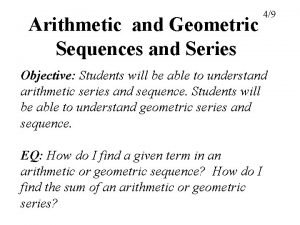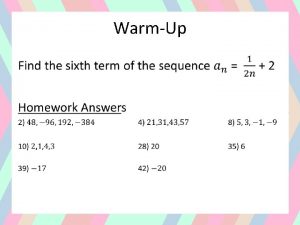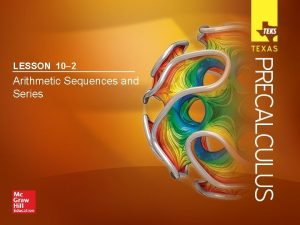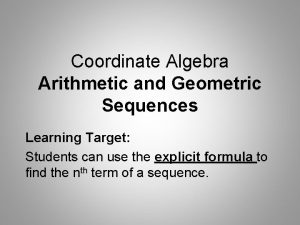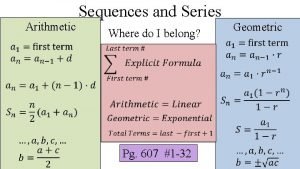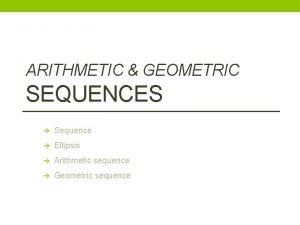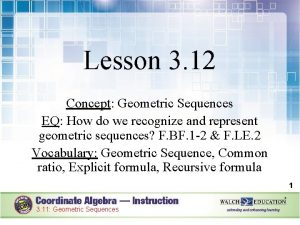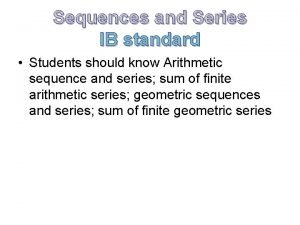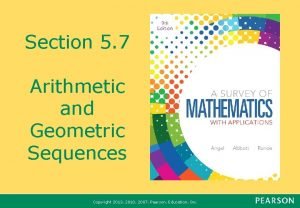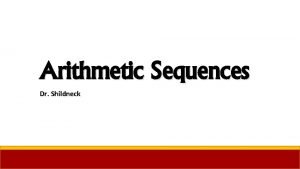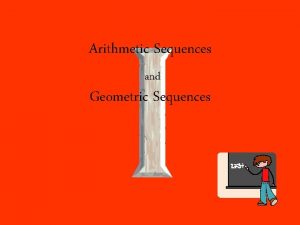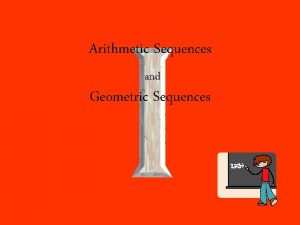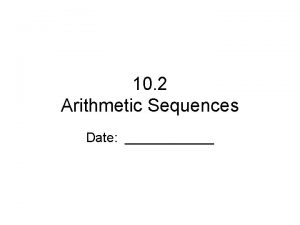6 1 Sequences and Arithmetic Sequences A sequence










- Slides: 10

6. 1 Sequences and Arithmetic Sequences A sequence is a set of numbers arranged in a definite order. The following numbers form a sequence: 2, 5, 8, 11, 14, 17, 20, 23, 26, 29, 32, . . . The numbers in a sequence are called the terms of the sequence. If a sequence has an infinite number of terms, it is called an infinite sequence. A finite sequence has a first term and a last term. Used alone, the word, “sequence”, usually refers to an infinite sequence. In a sequence, the first term is denoted by a 1, the second term is denoted by a 2, the third term is denoted by a 3, and so on. Using subscript notation, we can represent an infinite sequence by writing: a 1, a 2, a 3, . . . , an, . . . The term, an, represents the nth term, also called the general term. The general term of a sequence can be used to calculate terms of the sequence. Example 1. Find the first five terms of the sequence that has the general term: an = (n+1)(n-1) Calculating: a 1 = (1 + 1)(1 - 1) = (2)(0) = 0 a 2 = (2 + 1)(2 - 1) = (3)(1) = 3 a 3 = (3 + 1)(3 - 1) = (4)(2) = 8 Answer: In order, the first five a 4 = (4 + 1)(4 - 1) = (5)(3) = 15 terms are: 0, 3, 8, 15, and 24. a 5 = (5 + 1)(5 - 1) = (6)(4) = 24 Your Turn Problem #1 Find the first five terms for the sequence that has the general term: an = 6 2(n-1) Answer: In order, the first five terms are: 6, 12, 24, 48, and 96. 1

6. 1 Sequences and Arithmetic Sequences 2, 5, 8, 11, 14, 17, 20, 23, 26, 29, 32, . . . For the sequence above, the difference between a term and its preceding term is always 3. a 2 - a 1 = 5 - 2 = 3 , a 3 - a 2 = 8 - 5 = 3 , a 4 - a 3 = 11 - 8 = 3 , a 8 - a 7 = 23 - 20 = 3 , a 11 - a 10 = 32 - 29 = 3 , … An arithmetic sequence is a sequence in which the difference between a term and its preceding term is a constant. The number, d, is called the common difference for the arithmetic sequence. For the arithmetic sequence above, the common difference is 3. For an arithmetic sequence, the general term is: an = a 1 + (n-1)d, where a 1 is the first term and d is the common difference. Example 2. Find the general term for the arithmetic sequence; 7, -1, -9, -17, . . . The common difference, d = a 2 - a 1 = -1 - 7 = -8. (Note: we could have used the difference between any two consecutive terms, i. e. , d = a 4 - a 3 = -17 - (-9) = -8 ) Recall that in an arithmetic sequence, an = a 1 + (n-1)d So for the sequence above, an= 7 + (n-1)(-8) = 7 - 8 n + 8 Answer: an = -8 n + 15 Your Turn Problem #2 Find the general term for the arithmetic sequence: 2, 5, 8, 11, … Answer: an = 3 n - 1 2

6. 1 Sequences and Arithmetic Sequences The first term and the common difference can be any real numbers. Example 3. Find the general term of the arithmetic sequence Your Turn Problem #3 Find the general term for the arithmetic sequence: 3

6. 1 Sequences and Arithmetic Sequences For an arithmetic sequence, the formula for the general term can be used to find a desired term. Example 4. Find the 40 th term for the arithmetic sequence, 10, 6, 2, -2, . . . For this sequence, d = 6 – 10 = -4 So, an = 10 + (n-1)(-4) Since we want the 11 th term, let n = 11. Thus, a 11 = 10 + (40 -1)(-4) = 10 + (39)(-4) = 10 + (-156) = -146 Answer: The 11 th term, a 11 = -146 Your Turn Problem #4 Find the 17 th term for the arithmetic sequence: 1. 1, 2. 7, 4. 3, 5. 9, . . . 4

6. 1 Sequences and Arithmetic Sequences To find the sum of an arithmetic sequence, we need to know the first term, a 1, the last term, and the number of terms, n. The sum formula for the first n terms of an arithmetic sequence: Example 5. Find the sum of the first 40 terms of the arithmetic sequence: 6, 10, 14, 18, . . . For this sum, n = 40 For this sequence, d = 10 – 6 = 4 So, a 40 = = 6 + (40 – 1)(4) 6 + (39)(4) 6 + 156 162 Using the sum formula with n = 40, we get S 40 Answer: The sum of the first 40 terms is 3360. Your Turn Problem #5 Find the sum of the first 25 terms of the arithmetic sequence, 14, 7, 0, -7, . . . Answer: S 25 = -1750 5

6. 1 Sequences and Arithmetic Sequences Example 6. Find the sum of the first 58 terms of the arithmetic sequence, 2, 3 1/2, 5, 61/2, . . . For this sum, n = 58 For this sequence, d = 31/2 – 2 = 11/2 or So, a 58 = 2 + (58 – 1)(3/2) = 2 + (57)(3/2) = 2 + 171/2 = 175/2 or 871/2 Using the sum formula with n = 58, we get 3/2 S 58 Answer: The sum of the first 58 terms, S 58 = 2595 ½. Your Turn Problem #6 Find the sum of the first 37 terms of the arithmetic sequence, 8, 5 2/5, 24/5, 1/5, . . . 6

6. 1 Sequences and Arithmetic Sequences Example 7. Find 6 + 13 + 20 + 27 +. . . + 181 For this sum, we are not told that we are adding the terms of an arithmetic sequence. Therefore, we must first determine if this is, in fact, an arithmetic sequence. To do this, we must determine that there is a common difference between the terms. For this sequence, a 2 – a 1 = 7, a 3 – a 2 = 7, a 4 – a 3 = 7. So, there is a common difference, d = 7, which means that we are, in fact, working with an arithmetic sequence. In order to use the sum formula for an arithmetic sequence, we must determine the number of terms, n, that are being added. We know that an = a 1 + (n – 1)d. So, 181 = 6 + (n – 1)7 181 = 7 n – 1 26 = n Using the sum formula with n = 26, we get S 26 Answer: The sum of the first 26 terms, S 26 = 2431. Your Turn Problem #7 Find 19 + 8 + (-3) + (-14) +. . . + (-102) Answer: S 12 = -498 7

6. 1 Sequences and Arithmetic Sequences A sum of the consecutive terms of a sequence is called a series. An infinite series is the sum of the terms in an infinite sequence. A finite series is the sum of a finite number of consecutive terms from either a finite sequence or from an infinite sequence. A sum of consecutive terms from an arithmetic sequence is called an arithmetic series. The sum, Sn = a 1 + a 2 + a 3 +. . . + an-1 + an , is a finite series because only a finite number of consecutive terms from a sequence are added. We can write the sum of a finite series in a more compact way using the Greek capital letter, sigma, S. The letter, i, is called the index of summation (or just the index). Here, 1 (as part of the i = 1 under the S) is the lower limit of summation (or just the lower limit) and n (on top of the ) is the upper limit of summation (or just the upper limit). The index takes on all values from the lower limit to the upper limit, inclusive. Although we used the letter i as the index, other letters may be used for the index. is called summation notation. We read this symbol as, “the sum of ‘a’ sub-‘ i ’, as i goes from 1 to n. ” It means to add all of the terms in a sequence starting from the first term and adding through the n th term. The sum, , has an lower limit of 1 and an upper limit of n. Therefore, we have n terms. Example: 8

6. 1 Sequences and Arithmetic Sequences Example 8. Find Note that this sum of a finite series is actually the sum an arithmetic sequence. Replacing i with 1, 2, 3, . . . , we get -1 + 5 + 11 +. . . + 161. So we can use the sum formula for arithmetic sequence. n = 28 (28 – 1 +1 = 28) and the difference d = 6. For this sequence, a 1= 6(1) – 7 = 6 – 7 = -1 and a 28= 6(28) – 7 = 168 – 7 = 161 Using the sum formula with n = 28, we get S 28 Answer: The sum of the first 28 terms, S 28 = 2240. Your Turn Problem #8 Find 9

6. 1 Sequences and Arithmetic Sequences Example 9. Find We first note that the general term (3 i + 1) defines an arithmetic sequence and that (63 – 12) + 1 = 52 terms from this sequence are to be added. The first of these 52 terms to be added is a 1 = 3(12) + 1 = 37. The last of these 52 terms to be added is a 52 = 3(63) + 1 = 190. Because we are adding the terms of an arithmetic sequence, we can use the sum formula: Your Turn Problem #9 Find Answer: -645 The End 3 -6 -07 10
 Arithmetic and geometric sequences and series
Arithmetic and geometric sequences and series 10-2 arithmetic sequences and series
10-2 arithmetic sequences and series 10-2 arithmetic sequences and series
10-2 arithmetic sequences and series Arithmetic explicit formula
Arithmetic explicit formula Arithmetic series formula
Arithmetic series formula Explicit arithmetic formula
Explicit arithmetic formula Geometric progression examples
Geometric progression examples Lesson 3: arithmetic and geometric sequences
Lesson 3: arithmetic and geometric sequences Sum formula for arithmetic sequence
Sum formula for arithmetic sequence Geometric formula
Geometric formula Sum of geometric sequence
Sum of geometric sequence
